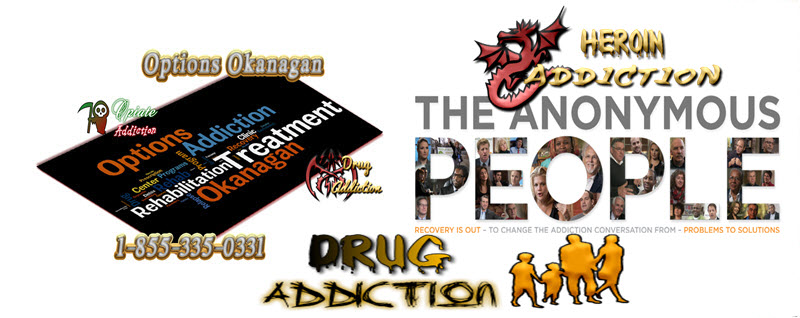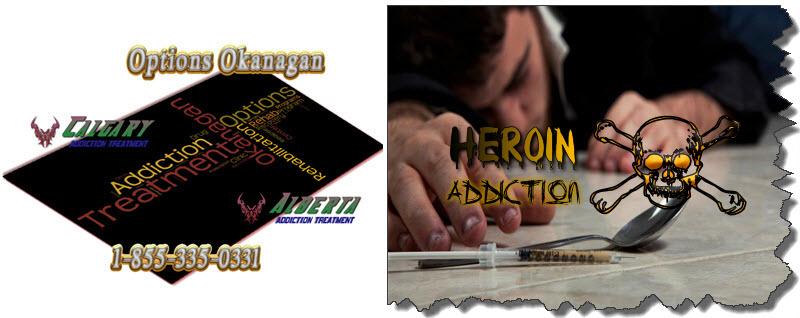Heroin and addiction in Calgary, Edmonton, Red Deer and other parts of Alberta by Options Okanagan Treatment Center in Kelowna, British Columbia treating drug addiction and recovery.
What Heroin Is
Heroin is sourced from the poppy plant, which is used to make morphine. The morphine is then treated and heroin is synthesized from that precursor drug. The name heroin comes from the work heroic. That’s because it was once thought that heroin would treat tuberculosis, a medical scourge, better than the morphine that was in use in the latter part of the 19th century. Unfortunately, as the problem of heroin addiction grew, the drug turned out to be much less than heroic in nature. Even with the smaller population of the United States during World War Two, it was estimated that there were half a million heroin addicts in the country. Those numbers were alarming then, and remain so today.
The drug itself consists of white powder. However, it sometimes is brown when the granules within the powder are crushed and a small chemical change occurs. While it can be taken in a variety of ways, the most common choice is by injections under the skin, into the muscles, or under the tongue. Other methods include smoking it or snorting it. It acts by depressing the central nervous system. The body functions slow down. There are so many street names that it is impossible to list all of them. Some of the more common names are China White, brown sugar, Jazz, smack, horse, Miss Hero, or simply H.
Side Effects Of Heroin
Heroin consumers refer to the side effects of the drug as a rush. The initial effects include feelings of ecstasy, euphoria, and rapid healing. These intensely pleasurable effects are soon followed by a contraction of the pupils and feelings of extreme drowsiness as well as:
1) Respiratory depression
2) Decrease in heart rate
3) Irregular and rapid pulse
4) Long term irregularities in the menses cycle
5) Frequent mood swings
6) Itchy skin
7) Abundant sweating
8) Constipation
9) Problems with blood pressure
10) More frequent urination
11) Difficulty concentrating
12) Dizziness
13) Vomiting
14) Nausea
Signs of a heroin overdose include respiratory arrest, coma, unconsciousness, delirium, and blue skin due to oxygen deprivation. Overdoses occur for a variety of reasons. An individual heroin dose may be purer, and therefore stronger, than heroin doses taken in the past. They also occur when heroin is used in combination with other drugs. The risk is especially high when its use is combined with depressants such as tranquilizers, GHD, or alcohol, although use with cocaine, ecstasy, or amphetamines increases the risk of an overdose as well.
Addiction To Heroin
Heroin users find that they become dependent on the drug quite quickly. Additionally, the more often someone uses it, the more often they need the drug in increasingly larger doses. A person is considered to be physically addicted when their body becomes so used to having it that they can no longer function effectively when they don’t have the drug in their system. Once addicted, the individual must partake of the drug on a daily basis. In general, these means that a minimum of three doses or more are needed to maintain some semblance of functionality. Because the need is so constant, the addict becomes obsessed with getting the drug. His daily life must revolve around getting the drug, taking the drug, and being under the drug’s effects. Since people who don’t use heroin won’t be able to help the addict get the drug or understand the need to take heroin, normal relationships become impossible and many addicts become homeless or enter a life of prostitution. For some, heroin acts as an anesthetic against past and current events that are too difficult to deal with emotionally. They constantly drift between a state of euphoria induced by the drug and intense cravings that spur severe bouts of restlessness and anxiety as well as other painful physical side effects related to withdrawal. Many addicts are unable to sleep and develop anorexia.
Treatment For Heroin Addiction
The only thing that a heroin addict focuses on is getting their next dose of the drug. When too much time has gone by since they last had some, they begin to experience discomfort physically. This is called withdrawal and the need for the drug is called craving. Health Canada reports that these symptoms begin within four to five hours of the last dose. Here are typical ailments during withdrawal:
1) Vomiting
2) Nausea
3) Abdominal cramps
4) Diarrhea
5) Tremors
6) Chills
7) Muscle spasms
8) Sweating
9) Runny nose
10) Insomnia
11) Severe anxiety
Because of the painful heroin withdrawal period, many addicts are afraid to go to a drug rehab center. In order to avoid complications due to withdrawal, a medical detox is sometimes necessary. Act immediately if someone you know want to to get off of heroin and is asking for help. There is only a short period of time to get them to a center before they change their mind.
If you are addicted to heroin and in need of help, Options Okanagan provides support during withdrawal and treatment for the addiction at their drug rehab center. Counselors are always available to guide you through the process when you call.
Options Okanagan Drug And Alcohol Treatment Centers in Kelowna, Salmon Arm and Vancouver, British Columbia – Men and Women are recovering and healing from Alcohol and Drug Abuse at our treatment center here in the Okanagan right now.
Our unique and distinctive drug treatment program allows men and women to come in from Calgary as well as Edmonton as we offer airport pickup.
Numerous clients come to us from Calgary and Edmonton and other locations in Alberta and even other provinces for Opiate addiction treatment, meth drug treatment, many other drug and alcohol addictions for rehabilitation because of the uniqueness of our treatment center.
Our Treatment Location:
Options Okanagan Heroin Treatment Center
551 Sherrydale Crescent, Kelowna, British Columbia, V1V 2E6
Toll Free Phone Number : 1-855-335-0331




